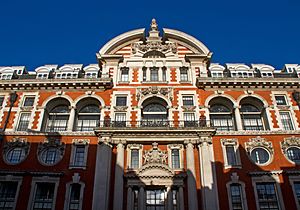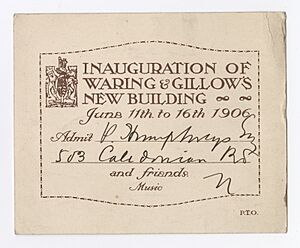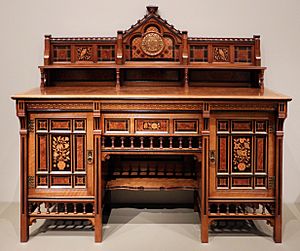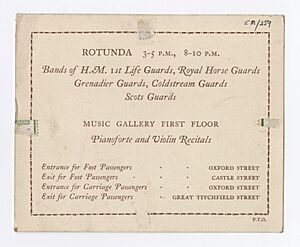- This page was last modified on 17 October 2025, at 10:18. Suggest an edit.
Waring & Gillow facts for kids
|
Trade name
|
|
|---|---|
|
Formerly
|
|
| Industry | Furniture manufacturing |
| Founded | 1897 |
| Headquarters |
,
United Kingdom
|
Waring & Gillow was a famous English company that made furniture and sold old, special items. It was created in 1897 when two companies, Gillows of Lancaster and London and Waring of Liverpool, joined together.
Contents
How It Started
Gillow & Co.
The story of Gillow's of Lancaster began around 1730. A man named Robert Gillow started a business making fancy furniture. He learned how to be a joiner, which is someone who builds things with wood.
In the 1730s, Robert Gillow found a way to make a lot of money. He sent mahogany furniture to the West Indies and brought back rum and sugar. After he passed away in 1772, his two sons, Richard and Robert, took over the business.
In 1764, a Gillow's store opened in London on Oxford Road, which is now Oxford Street. The company quickly became known for making very high-quality furniture. They sold their furniture to the richest families in the country.
Gillow & Co. created the Davenport desk and a special dining table that could get longer. Even so, some people at the time said their furniture was "solid, well made, but unadventurous."
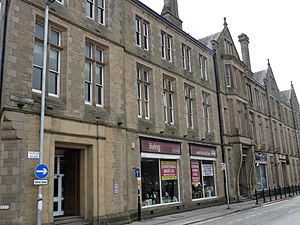
One of Waring & Gillow's old showrooms in Lancaster. It's a historic building!
S. J. Waring & Sons
The Waring company started in Liverpool. John Waring moved there from Belfast in 1835. He opened a business that made cabinets to sell to other stores.
His son, Samuel James Waring, took over and made the business much bigger in the 1880s. His company furnished hotels and public buildings all over Europe. In 1904, he started another company, Waring-White Building Company. This company built famous places like the Liverpool Cotton Exchange Building, the Selfridges department store, and the Ritz Hotel.
Samuel James Waring's son, also named Samuel James Waring, continued the family business. He was given a special title and became Baron Waring in 1922.
Company History
Waring & Gillow Joins Forces
Towards the end of the 1800s, Gillow & Co. started having money problems. They weren't making enough profit. So, in 1897, they began working with Waring of Liverpool. This partnership became official in 1903 when Waring & Gillow was formed.
The merger was a big deal. It also involved buying other companies like Collinson and Lock (who made cabinets) and T.J Bonter and Company (who sold carpets). The new combined company had a lot of money, about £1 million.
On July 10, 1897, The Times newspaper announced the merger. It said that joining these two strong companies would bring in more business and much bigger profits. Even after they merged, the companies sometimes still used their old labels on the furniture. The factory in Lancaster kept using the name Gillows & Co.
A new and impressive Waring & Gillow building opened in 1906 on Oxford Street in London. This showed that the two companies were truly working as one. The opening event happened from June 11 to 16, 1906. The University of Leeds has a special ticket from this event. The ticket shows there was music and entertainment. It also shows how grand the event was, with separate entrances for guests arriving in carriages.
A newspaper at the time said the new building was huge, covering 40,000 square feet. It had a beautiful domed Georgian Rotunda, which was 85 feet by 54 feet. This building was the company's main office for 65 years.
Throughout its history, Waring & Gillow got contracts to furnish many luxury yachts and ocean liners. These included the royal yacht HM Alberta (1901) and the Victoria and Albert III. They also worked on the Princesse Alice (1895) for Prince Albert of Monaco. Later, they furnished big ships like the P&O liner Viceroy of India (1929) and the famous Queen Mary (1936).
Like other fancy furniture stores back then, Waring & Gillow also furnished many new luxury hotels in London. These included the Carlton Hotel, the Waldorf, and the Ritz.
1900 Great Exhibition
In 1900, Waring & Gillow helped decorate the British section of the Paris Exhibition. This was a huge international show. Their successful display helped them build strong relationships with other makers and customers around the world. They even opened new workshops in Paris.
The 1920s
In the late 1920s, Waring & Gillow opened a new department for modern art. They hired a Russian designer named Serge Chermayeff to lead it. Chermayeff worked with French designer Paul Follot, who was in charge of Waring & Gillow in Paris. They tried to bring a modern Art Deco style to the company.
In 1928, they opened a large exhibition in London called Modern Art in Decoration and Furnishing. It had 68 decorated rooms on the 4th and 5th floors of the Oxford Street building. The exhibition ran from November 1928 to January 1929.
Financial Troubles and Changes
In the 1930s, the Great Depression hit, which was a time when many people lost their jobs and money. Lord Waring had also spent a lot of money in the years before. These things caused money problems for the company. Waring had to step down as chairman in September 1930, though he remained as President.
The company had to reorganize in 1932. It was renamed Waring & Gillow (1932) Ltd.
First World War Efforts
During the First World War, the Lancaster factory stopped making furniture. Instead, it made things for the war. They made ammunition chests for the Navy and propellers for De Havilland DH9 aircraft. They also set up a huge tent-making factory in London, employing 8,000 workers.
Workers in Cambridge Row made tents, gas masks for horses, and aircraft wings. The company also made ammunition belts for machine guns, nosebags for horses, and special clothing to protect against gas attacks.
Second World War Efforts
During the Second World War, the factory in Cambridge Grove, Hammersmith, made parts for gliders and the Mosquito aircraft. The part of the company that made soft furnishings (like sofas) made kit-bags, tents, and camouflage nets.
Lord Waring passed away in 1940, early in the war.
After the Wars
In 1953, a large retail company called Great Universal Stores bought Waring & Gillow. However, a big part of the business was later sold to another furniture chain, "John Peters," in 1960. The John Peters company then changed its name to Waring and Gillow (Holdings) Ltd.
After the war, the company's business started to slow down. The workshops in Lancaster closed on March 31, 1962. Two years later, this building became the first home of the new University of Lancaster.
In 1980, Waring & Gillow talked about taking over another furniture company called Maple & Co.. Maple directors first said no, but Waring & Gillow kept buying shares of the company. Eventually, they owned more than half of the shares, which gave them control. The company then became Maple, Waring and Gillow.
In 1988, Allied Carpets bought 48 of the 87 Gillows stores. The company then became part of Allied Maples Group Ltd, which also includes Allied Carpets.
See also
- Joseph Gillow
- Maple & Co.
- Druce & Co.
- Cabinetry
- Upholstery

